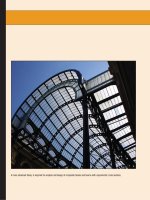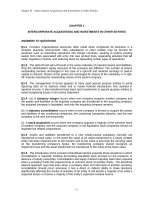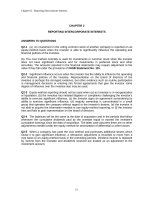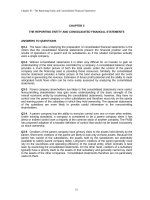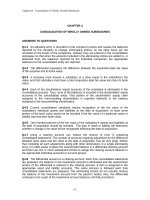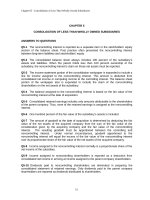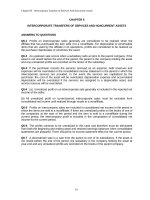Solution manual mechanics of materials 8th edition hibbeler chapter 07
Bạn đang xem bản rút gọn của tài liệu. Xem và tải ngay bản đầy đủ của tài liệu tại đây (4.24 MB, 61 trang )
07 Solutions 46060
5/26/10
2:04 PM
Page 472
© 2010 Pearson Education, Inc., Upper Saddle River, NJ. All rights reserved. This material is protected under all copyright laws as they currently
exist. No portion of this material may be reproduced, in any form or by any means, without permission in writing from the publisher.
•7–1.
If the wide-flange beam is subjected to a shear of
V = 20 kN, determine the shear stress on the web at A.
Indicate the shear-stress components on a volume element
located at this point.
200 mm
A
20 mm
20 mm
B
V
300 mm
200 mm
The moment of inertia of the cross-section about the neutral axis is
I =
1
1
(0.2)(0.343) (0.18)(0.33) = 0.2501(10 - 3) m4
12
12
From Fig. a,
QA = y¿A¿ = 0.16 (0.02)(0.2) = 0.64(10 - 3) m3
Applying the shear formula,
VQA
20(103)[0.64(10 - 3)]
=
tA =
It
0.2501(10 - 3)(0.02)
= 2.559(106) Pa = 2.56 MPa
Ans.
The shear stress component at A is represented by the volume element shown in
Fig. b.
472
20 mm
07 Solutions 46060
5/26/10
2:04 PM
Page 473
© 2010 Pearson Education, Inc., Upper Saddle River, NJ. All rights reserved. This material is protected under all copyright laws as they currently
exist. No portion of this material may be reproduced, in any form or by any means, without permission in writing from the publisher.
7–2. If the wide-flange beam is subjected to a shear of
V = 20 kN, determine the maximum shear stress in the beam.
200 mm
A
20 mm
20 mm
B
V
300 mm
200 mm
The moment of inertia of the cross-section about the neutral axis is
I =
1
1
(0.2)(0.343) (0.18)(0.33) = 0.2501(10 - 3) m4
12
12
From Fig. a.
Qmax = ©y¿A¿ = 0.16 (0.02)(0.2) + 0.075 (0.15)(0.02) = 0.865(10 - 3) m3
The maximum shear stress occurs at the points along neutral axis since Q is
maximum and thicknest t is the smallest.
tmax =
VQmax
20(103) [0.865(10 - 3)]
=
It
0.2501(10 - 3) (0.02)
= 3.459(106) Pa = 3.46 MPa
Ans.
473
20 mm
07 Solutions 46060
5/26/10
2:04 PM
Page 474
© 2010 Pearson Education, Inc., Upper Saddle River, NJ. All rights reserved. This material is protected under all copyright laws as they currently
exist. No portion of this material may be reproduced, in any form or by any means, without permission in writing from the publisher.
7–3. If the wide-flange beam is subjected to a shear of
V = 20 kN, determine the shear force resisted by the web
of the beam.
200 mm
A
20 mm
20 mm
B
V
300 mm
200 mm
The moment of inertia of the cross-section about the neutral axis is
I =
1
1
(0.2)(0.343) (0.18)(0.33) = 0.2501(10 - 3) m4
12
12
For 0 … y 6 0.15 m, Fig. a, Q as a function of y is
Q = ©y¿A¿ = 0.16 (0.02)(0.2) +
1
(y + 0.15)(0.15 - y)(0.02)
2
= 0.865(10 - 3) - 0.01y2
For 0 … y 6 0.15 m, t = 0.02 m. Thus.
t =
20(103) C 0.865(10 - 3) - 0.01y2 D
VQ
=
It
0.2501(10 - 3) (0.02)
=
E 3.459(106) - 39.99(106) y2 F Pa.
The sheer force resisted by the web is,
0.15 m
Vw = 2
L0
0.15 m
tdA = 2
L0
C 3.459(106) - 39.99(106) y2 D (0.02 dy)
= 18.95 (103) N = 19.0 kN
Ans.
474
20 mm
07 Solutions 46060
5/26/10
2:04 PM
Page 475
© 2010 Pearson Education, Inc., Upper Saddle River, NJ. All rights reserved. This material is protected under all copyright laws as they currently
exist. No portion of this material may be reproduced, in any form or by any means, without permission in writing from the publisher.
*7–4. If the T-beam is subjected to a vertical shear of
V = 12 kip, determine the maximum shear stress in the
beam. Also, compute the shear-stress jump at the flangeweb junction AB. Sketch the variation of the shear-stress
intensity over the entire cross section.
4 in.
4 in.
3 in.
4 in.
B
6 in.
A
V ϭ 12 kip
Section Properties:
y =
INA =
1.5(12)(3) + 6(4)(6)
©yA
=
= 3.30 in.
©A
12(3) + 4(6)
1
1
(12) A 33 B + 12(3)(3.30 - 1.5)2 +
(4) A 63 B + 4(6)(6 - 3.30)2
12
12
= 390.60 in4
Qmax = y1œ A¿ = 2.85(5.7)(4) = 64.98 in3
QAB = y2œ A¿ = 1.8(3)(12) = 64.8 in3
Shear Stress: Applying the shear formula t =
tmax =
VQ
It
VQmax
12(64.98)
=
= 0.499 ksi
It
390.60(4)
Ans.
(tAB)f =
VQAB
12(64.8)
=
= 0.166 ksi
Itf
390.60(12)
Ans.
(tAB)W =
VQAB
12(64.8)
=
= 0.498 ksi
I tW
390.60(4)
Ans.
475
07 Solutions 46060
5/26/10
2:04 PM
Page 476
© 2010 Pearson Education, Inc., Upper Saddle River, NJ. All rights reserved. This material is protected under all copyright laws as they currently
exist. No portion of this material may be reproduced, in any form or by any means, without permission in writing from the publisher.
•7–5.
If the T-beam is subjected to a vertical shear of
V = 12 kip, determine the vertical shear force resisted by
the flange.
4 in.
4 in.
3 in.
4 in.
B
6 in.
A
V ϭ 12 kip
Section Properties:
y =
©yA
1.5(12)(3) + 6(4)(6)
=
= 3.30 in.
©A
12(3) + 4(6)
INA =
1
1
(12) A 33 B + 12(3)(3.30 - 1.5)2 +
(4) A 63 B + 6(4)(6 - 3.30)2
12
12
= 390.60 in4
Q = y¿A¿ = (1.65 + 0.5y)(3.3 - y)(12) = 65.34 - 6y2
Shear Stress: Applying the shear formula
t =
VQ
12(65.34 - 6y2)
=
It
390.60(12)
= 0.16728 - 0.01536y2
Resultant Shear Force: For the flange
Vf =
tdA
LA
3.3 in
=
L0.3 in
A 0.16728 - 0.01536y2 B (12dy)
= 3.82 kip
Ans.
476
07 Solutions 46060
5/26/10
2:04 PM
Page 477
© 2010 Pearson Education, Inc., Upper Saddle River, NJ. All rights reserved. This material is protected under all copyright laws as they currently
exist. No portion of this material may be reproduced, in any form or by any means, without permission in writing from the publisher.
7–6. If the beam is subjected to a shear of V = 15 kN,
determine the web’s shear stress at A and B. Indicate the
shear-stress components on a volume element located
at these points. Show that the neutral axis is located at
y = 0.1747 m from the bottom and INA = 0.2182110-32 m4.
200 mm
A
30 mm
25 mm
V
(0.015)(0.125)(0.03) + (0.155)(0.025)(0.25) + (0.295)(0.2)(0.03)
y =
= 0.1747 m
0.125(0.03) + (0.025)(0.25) + (0.2)(0.03)
I =
1
(0.125)(0.033) + 0.125(0.03)(0.1747 - 0.015)2
12
+
1
(0.025)(0.253) + 0.25(0.025)(0.1747 - 0.155)2
12
+
1
(0.2)(0.033) + 0.2(0.03)(0.295 - 0.1747)2 = 0.218182 (10 - 3) m4
12
B
250 mm
30 mm
125 mm
œ
QA = yAA
= (0.310 - 0.015 - 0.1747)(0.2)(0.03) = 0.7219 (10 - 3) m3
QB = yABœ = (0.1747 - 0.015)(0.125)(0.03) = 0.59883 (10 - 3) m3
tA =
15(103)(0.7219)(10 - 3)
VQA
= 1.99 MPa
=
It
0.218182(10 - 3)(0.025)
Ans.
tB =
VQB
15(103)(0.59883)(10 - 3)
= 1.65 MPa
=
It
0.218182(10 - 3)0.025)
Ans.
7–7. If the wide-flange beam is subjected to a shear of
V = 30 kN, determine the maximum shear stress in the beam.
200 mm
A
30 mm
25 mm
V
B
250 mm
30 mm
Section Properties:
I =
1
1
(0.2)(0.310)3 (0.175)(0.250)3 = 268.652(10) - 6 m4
12
12
Qmax = © y¿A = 0.0625(0.125)(0.025) + 0.140(0.2)(0.030) = 1.0353(10) - 3 m3
tmax =
VQ
30(10)3(1.0353)(10) - 3
= 4.62 MPa
=
It
268.652(10) - 6 (0.025)
Ans.
477
200 mm
07 Solutions 46060
5/26/10
2:04 PM
Page 478
© 2010 Pearson Education, Inc., Upper Saddle River, NJ. All rights reserved. This material is protected under all copyright laws as they currently
exist. No portion of this material may be reproduced, in any form or by any means, without permission in writing from the publisher.
*7–8. If the wide-flange beam is subjected to a shear of
V = 30 kN, determine the shear force resisted by the web
of the beam.
200 mm
A
30 mm
1
1
(0.2)(0.310)3 (0.175)(0.250)3 = 268.652(10) - 6 m4
12
12
I =
Q = a
25 mm
V
B
0.155 + y
b (0.155 - y)(0.2) = 0.1(0.024025 - y2)
2
250 mm
30(10)3(0.1)(0.024025 - y2)
tf =
268.652(10)
-6
30 mm
200 mm
(0.2)
0.155
Vf =
L
tf dA = 55.8343(10)6
L0.125
= 11.1669(10)6[ 0.024025y -
(0.024025 - y2)(0.2 dy)
1 3 0.155
y ]
2 0.125
Vf = 1.457 kN
Vw = 30 - 2(1.457) = 27.1 kN
Ans.
•7–9. Determine the largest shear force V that the member
can sustain if the allowable shear stress is tallow = 8 ksi.
3 in.
1 in.
V
3 in. 1 in.
1 in.
y =
(0.5)(1)(5) + 2 [(2)(1)(2)]
= 1.1667 in.
1 (5) + 2 (1)(2)
I =
1
(5)(13) + 5 (1)(1.1667 - 0.5)2
12
+ 2a
1
b (1)(23) + 2 (1)(2)(2 - 1.1667)2 = 6.75 in4
12
Qmax = ©y¿A¿ = 2 (0.91665)(1.8333)(1) = 3.3611 in3
tmax = tallow =
8 (103) = -
VQmax
It
V (3.3611)
6.75 (2)(1)
V = 32132 lb = 32.1 kip
Ans.
478
07 Solutions 46060
5/26/10
2:04 PM
Page 479
© 2010 Pearson Education, Inc., Upper Saddle River, NJ. All rights reserved. This material is protected under all copyright laws as they currently
exist. No portion of this material may be reproduced, in any form or by any means, without permission in writing from the publisher.
7–10. If the applied shear force V = 18 kip, determine the
maximum shear stress in the member.
3 in.
1 in.
V
3 in. 1 in.
1 in.
y =
(0.5)(1)(5) + 2 [(2)(1)(2)]
= 1.1667 in.
1 (5) + 2 (1)(2)
I =
1
(5)(13) + 5 (1)(1.1667 - 0.5)2
12
+ 2a
1
b (1)(23) + 2 (1)(2)(2 - 1.1667) = 6.75 in4
12
Qmax = ©y¿A¿ = 2 (0.91665)(1.8333)(1) = 3.3611 in3
tmax =
18(3.3611)
VQmax
=
= 4.48 ksi
It
6.75 (2)(1)
Ans.
7–11. The wood beam has an allowable shear stress of
tallow = 7 MPa. Determine the maximum shear force V that
can be applied to the cross section.
50 mm
50 mm
100 mm
50 mm
200 mm
V
50 mm
I =
1
1
(0.2)(0.2)3 (0.1)(0.1)3 = 125(10 - 6) m4
12
12
tallow =
7(106) =
VQmax
It
V[(0.075)(0.1)(0.05) + 2(0.05)(0.1)(0.05)]
125(10 - 6)(0.1)
V = 100 kN
Ans.
479
07 Solutions 46060
5/26/10
2:04 PM
Page 480
© 2010 Pearson Education, Inc., Upper Saddle River, NJ. All rights reserved. This material is protected under all copyright laws as they currently
exist. No portion of this material may be reproduced, in any form or by any means, without permission in writing from the publisher.
*7–12. The beam has a rectangular cross section and is
made of wood having an allowable shear stress of tallow =
200 psi. Determine the maximum shear force V that can be
developed in the cross section of the beam. Also, plot the
shear-stress variation over the cross section.
V
12 in.
8 in.
Section Properties The moment of inertia of the cross-section about the neutral axis is
I =
1
(8) (123) = 1152 in4
12
Q as the function of y, Fig. a,
Q =
1
(y + 6)(6 - y)(8) = 4 (36 - y2)
2
Qmax occurs when y = 0. Thus,
Qmax = 4(36 - 02) = 144 in3
The maximum shear stress occurs of points along the neutral axis since Q is
maximum and the thickness t = 8 in. is constant.
tallow =
VQmax
;
It
200 =
V(144)
1152(8)
V = 12800 16 = 12.8 kip
Ans.
Thus, the shear stress distribution as a function of y is
t =
12.8(103) C 4(36 - y2) D
VQ
=
It
1152 (8)
=
E 5.56 (36 - y2) F psi
480
07 Solutions 46060
5/26/10
2:04 PM
Page 481
© 2010 Pearson Education, Inc., Upper Saddle River, NJ. All rights reserved. This material is protected under all copyright laws as they currently
exist. No portion of this material may be reproduced, in any form or by any means, without permission in writing from the publisher.
7–13. Determine the maximum shear stress in the strut if
it is subjected to a shear force of V = 20 kN.
12 mm
Section Properties:
INA
60 mm
1
1
=
(0.12) A 0.0843 B (0.04) A 0.063 B
12
12
V
= 5.20704 A 10 - 6 B m4
12 mm
80 mm
Qmax = ©y¿A¿
20 mm
20 mm
= 0.015(0.08)(0.03) + 0.036(0.012)(0.12)
= 87.84 A 10 - 6 B m3
Maximum Shear Stress: Maximum shear stress occurs at the point where the
neutral axis passes through the section.
Applying the shear formula
tmax =
VQmax
It
20(103)(87.84)(10 - 6)
=
5.20704(10 - 6)(0.08)
= 4 22 MPa
Ans.
7–14. Determine the maximum shear force V that the
strut can support if the allowable shear stress for the
material is tallow = 40 MPa.
12 mm
60 mm
Section Properties:
INA =
V
1
1
(0.12) A 0.0843 B (0.04) A 0.063 B
12
12
12 mm
= 5.20704 A 10 - 6 B m4
80 mm
Qmax = ©y¿A¿
20 mm
= 0.015(0.08)(0.03) + 0.036(0.012)(0.12)
= 87.84 A 10 - 6 B m3
Allowable shear stress: Maximum shear stress occurs at the point where the neutral
axis passes through the section.
Applying the shear formula
tmax = tallow =
40 A 106 B =
VQmax
It
V(87.84)(10 - 6)
5.20704(10 - 6)(0.08)
V = 189 692 N = 190 kN
Ans.
481
20 mm
07 Solutions 46060
5/26/10
2:04 PM
Page 482
© 2010 Pearson Education, Inc., Upper Saddle River, NJ. All rights reserved. This material is protected under all copyright laws as they currently
exist. No portion of this material may be reproduced, in any form or by any means, without permission in writing from the publisher.
7–15. Plot the shear-stress distribution over the cross
section of a rod that has a radius c. By what factor is the
maximum shear stress greater than the average shear stress
acting over the cross section?
c
y
V
x = 2c2 - y2 ;
p 4
c
4
I =
t = 2 x = 2 2c2 - y2
dA = 2 x dy = 22c2 - y2 dy
dQ = ydA = 2y 2c2 - y2 dy
x
Q =
Ly
2y2c2 - y2 dy = -
3 x
2
2 2
2
(c - y2)2 | y = (c2 - y2)3
3
3
3
V[23 (c2 - y2)2]
VQ
4V 2
t =
=
=
[c - y2)
p 4
2
2
It
3pc4
( 4 c )(2 2c - y )
The maximum shear stress occur when y = 0
tmax =
4V
3 p c2
tavg =
V
V
=
A
p c2
The faector =
tmax
=
tavg
4V
3 pc2
V
pc2
=
4
3
Ans.
482
07 Solutions 46060
5/26/10
2:04 PM
Page 483
© 2010 Pearson Education, Inc., Upper Saddle River, NJ. All rights reserved. This material is protected under all copyright laws as they currently
exist. No portion of this material may be reproduced, in any form or by any means, without permission in writing from the publisher.
*7–16. A member has a cross section in the form of an
equilateral triangle. If it is subjected to a shear force V,
determine the maximum average shear stress in the member
using the shear formula. Should the shear formula actually be
used to predict this value? Explain.
I =
V
1
(a)(h)3
36
y
h
;
=
x
a>2
Q =
a
LA¿
Q = a
y =
y dA = 2c a
2h
x
a
1
2
2
b (x)(y) a h - yb d
2
3
3
4h2
2x
b (x2)a 1 b
a
3a
t = 2x
t =
t =
V(4h2>3a)(x2)(1 - 2x
VQ
a)
=
It
((1>36)(a)(h3))(2x)
24V(x - a2 x2)
a2h
24V
4
dt
= 2 2 a 1 - xb = 0
a
dx
ah
At x =
y =
a
4
h
2h a
a b =
a 4
2
tmax =
24V a
2 a
a b a1 - a b b
a 4
a2h 4
tmax =
3V
ah
Ans.
No, because the shear stress is not perpendicular to the boundary. See Sec. 7-3.
483
h
07 Solutions 46060
5/26/10
2:04 PM
Page 484
© 2010 Pearson Education, Inc., Upper Saddle River, NJ. All rights reserved. This material is protected under all copyright laws as they currently
exist. No portion of this material may be reproduced, in any form or by any means, without permission in writing from the publisher.
•7–17.
Determine the maximum shear stress in the strut if
it is subjected to a shear force of V = 600 kN.
30 mm
150 mm
V
100 mm
100 mm
100 mm
The moment of inertia of the cross-section about the neutral axis is
I =
1
1
(0.3)(0.213) (0.2)(0.153) = 0.175275(10 - 3) m4
12
12
From Fig. a,
Qmax = ©y¿A¿ = 0.09(0.03)(0.3) + 0.0375(0.075)(0.1)
= 1.09125(10 - 3) m3
The maximum shear stress occurs at the points along the neutral axis since Q is
maximum and thickness t = 0.1 m is the smallest.
tmax =
VQmax
600(103)[1.09125(10 - 3)]
=
It
0.175275(10 - 3) (0.1)
= 37.36(106) Pa = 37.4 MPa
Ans.
484
30 mm
07 Solutions 46060
5/26/10
2:04 PM
Page 485
© 2010 Pearson Education, Inc., Upper Saddle River, NJ. All rights reserved. This material is protected under all copyright laws as they currently
exist. No portion of this material may be reproduced, in any form or by any means, without permission in writing from the publisher.
7–18. Determine the maximum shear force V that the strut
can support if the allowable shear stress for the material is
tallow = 45 MPa.
30 mm
150 mm
V
100 mm
100 mm
100 mm
The moment of inertia of the cross-section about the neutral axis is
I =
1
1
(0.3)(0.213) (0.2)(0.153) = 0.175275 (10 - 3) m4
12
12
From Fig. a
Qmax = ©y¿A¿ = 0.09(0.03)(0.3) + 0.0375 (0.075)(0.1)
= 1.09125 (10 - 3) m3
The maximum shear stress occeurs at the points along the neutral axis since Q is
maximum and thickness t = 0.1 m is the smallest.
tallow =
VQmax
;
It
45(106) =
V C 1.09125(10 - 3) D
0.175275(10 - 3)(0.1)
V = 722.78(103) N = 723 kN
Ans.
485
30 mm
07 Solutions 46060
5/26/10
2:04 PM
Page 486
© 2010 Pearson Education, Inc., Upper Saddle River, NJ. All rights reserved. This material is protected under all copyright laws as they currently
exist. No portion of this material may be reproduced, in any form or by any means, without permission in writing from the publisher.
7–19. Plot the intensity of the shear stress distributed over
the cross section of the strut if it is subjected to a shear force
of V = 600 kN.
30 mm
The moment of inertia of the cross-section about the neutral axis is
I =
1
1
(0.3)(0.213) (0.2)(0.153) = 0.175275 (10 - 3) m4
12
12
For 0.075 m 6 y … 0.105 m, Fig. a, Q as a function of y is
Q = y¿A¿ =
1
(0.105 + y) (0.105 - y)(0.3) = 1.65375(10 - 3) - 0.15y2
2
For 0 … y 6 0.075 m, Fig. b, Q as a function of y is
Q = ©y¿A¿ = 0.09 (0.03)(0.3) +
1
(0.075 + y)(0.075 - y)(0.1) = 1.09125(10 - 3) - 0.05 y2
2
For 0.075 m 6 y … 0.105 m, t = 0.3 m. Thus,
t =
600 (103) C 1.65375(10 - 3) - 0.15y2 D
VQ
= (18.8703 - 1711.60y2) MPa
=
It
0.175275(10 - 3) (0.3)
At y = 0.075 m and y = 0.105 m,
t|y = 0.015 m = 9.24 MPa
ty = 0.105 m = 0
For 0 … y 6 0.075 m, t = 0.1 m. Thus,
t =
VQ
600 (103) [1.09125(10 - 3) - 0.05 y2]
= (37.3556 - 1711.60 y2) MPa
=
It
0.175275(10 - 3) (0.1)
At y = 0 and y = 0.075 m,
t|y = 0 = 37.4 MPa
ty = 0.075 m = 27.7 MPa
The plot shear stress distribution over the cross-section is shown in Fig. c.
486
150 mm
V
100 mm
100 mm
100 mm
30 mm
07 Solutions 46060
5/26/10
2:04 PM
Page 487
© 2010 Pearson Education, Inc., Upper Saddle River, NJ. All rights reserved. This material is protected under all copyright laws as they currently
exist. No portion of this material may be reproduced, in any form or by any means, without permission in writing from the publisher.
*7–20. The steel rod is subjected to a shear of 30 kip.
Determine the maximum shear stress in the rod.
The moment of inertia of the ciralor cross-section about the neutral axis (x axis) is
p
p
I = r4 = (24) = 4 p in4
4
4
30 kip
dQ = ydA = y (2xdy) = 2xy dy
1
However, from the equation of the circle, x = (4 - y2)2 , Then
1
dQ = 2y(4 - y2)2 dy
Thus, Q for the area above y is
2 in
1
2y (4 - y2)2 dy
Ly
3 2 in
2
= - (4 - y2)2 Η
y
3
=
3
2
(4 - y2)2
3
1
Here, t = 2x = 2 (4 - y2)2 . Thus
30 C 23 (4 - y2)2 D
VQ
=
t =
1
It
4p C 2(4 - y2)2 D
3
t =
5
(4 - y2) ksi
2p
By inspecting this equation, t = tmax at y = 0. Thus
¿=
tmax
A
2 in.
Q for the differential area shown shaded in Fig. a is
Q =
1 in.
20
10
= 3.18 ksi
=
p
2p
Ans.
487
07 Solutions 46060
5/26/10
2:04 PM
Page 488
© 2010 Pearson Education, Inc., Upper Saddle River, NJ. All rights reserved. This material is protected under all copyright laws as they currently
exist. No portion of this material may be reproduced, in any form or by any means, without permission in writing from the publisher.
•7–21.
The steel rod is subjected to a shear of 30 kip.
Determine the shear stress at point A. Show the result on a
volume element at this point.
1 in.
A
The moment of inertia of the circular cross-section about the neutral axis (x axis) is
I =
2 in.
p 4
p
r = (24) = 4p in4
4
4
30 kip
Q for the differential area shown in Fig. a is
dQ = ydA = y (2xdy) = 2xy dy
1
However, from the equation of the circle, x = (4 - y2)2 , Then
1
dQ = 2y (4 - y2)2 dy
Thus, Q for the area above y is
2 in.
1
Q =
Ly
= -
2y (4 - y2)2 dy
2 in.
3
3
2
2
(4 - y2)2 `
= (4 - y2)2
3
3
y
1
Here t = 2x = 2 (4 - y2)2 . Thus,
30 C 23 (4 - y2)2 D
VQ
=
t =
1
It
4p C 2(4 - y2)2 D
3
t =
5
(4 - y2) ksi
2p
For point A, y = 1 in. Thus
tA =
5
(4 - 12) = 2.39 ksi
2p
Ans.
The state of shear stress at point A can be represented by the volume element
shown in Fig. b.
488
07 Solutions 46060
5/26/10
2:04 PM
Page 489
© 2010 Pearson Education, Inc., Upper Saddle River, NJ. All rights reserved. This material is protected under all copyright laws as they currently
exist. No portion of this material may be reproduced, in any form or by any means, without permission in writing from the publisher.
7–22. Determine the shear stress at point B on the web of
the cantilevered strut at section a–a.
2 kN
250 mm
a
250 mm
4 kN
300 mm
a
20 mm
70 mm
(0.01)(0.05)(0.02) + (0.055)(0.07)(0.02)
y =
= 0.03625 m
(0.05)(0.02) + (0.07)(0.02)
I =
+
B
20 mm
50 mm
1
(0.05)(0.023) + (0.05)(0.02)(0.03625 - 0.01)2
12
1
(0.02)(0.073) + (0.02)(0.07)(0.055 - 0.03625)2 = 1.78625(10 - 6) m4
12
yBœ = 0.03625 - 0.01 = 0.02625 m
QB = (0.02)(0.05)(0.02625) = 26.25(10 - 6) m3
tB =
6(103)(26.25)(10 - 6)
VQB
=
It
1.78622(10 - 6)(0.02)
= 4.41 MPa
Ans.
7–23. Determine the maximum shear stress acting at
section a–a of the cantilevered strut.
2 kN
250 mm
a
250 mm
4 kN
300 mm
a
20 mm
70 mm
y =
(0.01)(0.05)(0.02) + (0.055)(0.07)(0.02)
= 0.03625 m
(0.05)(0.02) + (0.07)(0.02)
I =
1
(0.05)(0.023) + (0.05)(0.02)(0.03625 - 0.01)2
12
+
20 mm
50 mm
1
(0.02)(0.073) + (0.02)(0.07)(0.055 - 0.03625)2 = 1.78625(10 - 6) m4
12
Qmax = y¿A¿ = (0.026875)(0.05375)(0.02) = 28.8906(10 - 6) m3
tmax =
B
VQmax
6(103)(28.8906)(10 - 6)
=
It
1.78625(10 - 6)(0.02)
= 4.85 MPa
Ans.
489
07 Solutions 46060
5/26/10
2:04 PM
Page 490
© 2010 Pearson Education, Inc., Upper Saddle River, NJ. All rights reserved. This material is protected under all copyright laws as they currently
exist. No portion of this material may be reproduced, in any form or by any means, without permission in writing from the publisher.
*7–24. Determine the maximum shear stress in the T-beam
at the critical section where the internal shear force is
maximum.
10 kN/m
A
1.5 m
3m
The shear diagram is shown in Fig. b. As indicated, Vmax = 27.5 kN
150 mm
The neutral axis passes through centroid c of the cross-section, Fig. c.
'
0.075(0.15)(0.03) + 0.165(0.03)(0.15)
© y A
=
y =
©A
0.15(0.03) + 0.03(0.15)
150 mm
1
(0.03)(0.153) + 0.03(0.15)(0.12 - 0.075)2
12
+
1
(0.15)(0.033) + 0.15(0.03)(0.165 - 0.12)2
12
= 27.0 (10 - 6) m4
From Fig. d,
Qmax = y¿A¿ = 0.06(0.12)(0.03)
= 0.216 (10 - 3) m3
The maximum shear stress occurs at points on the neutral axis since Q is maximum
and thickness t = 0.03 m is the smallest.
tmax =
27.5(103) C 0.216(10 - 3) D
Vmax Qmax
=
It
27.0(10 - 6)(0.03)
= 7.333(106) Pa
= 7.33 MPa
Ans.
490
30 mm
30 mm
= 0.12 m
I =
B
C
The FBD of the beam is shown in Fig. a,
1.5 m
07 Solutions 46060
5/26/10
2:04 PM
Page 491
© 2010 Pearson Education, Inc., Upper Saddle River, NJ. All rights reserved. This material is protected under all copyright laws as they currently
exist. No portion of this material may be reproduced, in any form or by any means, without permission in writing from the publisher.
•7–25.
Determine the maximum shear stress in the
T-beam at point C. Show the result on a volume element
at this point.
10 kN/m
A
B
C
1.5 m
3m
150 mm
150 mm
30 mm
using the method of sections,
+ c ©Fy = 0;
VC + 17.5 -
1
(5)(1.5) = 0
2
VC = -13.75 kN
The neutral axis passes through centroid C of the cross-section,
0.075 (0.15)(0.03) + 0.165(0.03)(0.15)
©yA
=
©A
0.15(0.03) + 0.03(0.15)
y =
= 0.12 m
I =
1
(0.03)(0.15) + 0.03(0.15)(0.12 - 0.075)2
12
+
1
(0.15)(0.033) + 0.15(0.03)(0.165 - 0.12)2
12
= 27.0 (10 - 6) m4
Qmax = y¿A¿ = 0.06 (0.12)(0.03)
= 0.216 (10 - 3) m3 490
The maximum shear stress occurs at points on the neutral axis since Q is maximum
and thickness t = 0.03 m is the smallest.
tmax =
30 mm
13.75(103) C 0.216(10 - 3) D
VC Qmax
=
It
27.0(10 - 6) (0.03)
= 3.667(106) Pa = 3.67 MPa
Ans.
491
1.5 m
07 Solutions 46060
5/26/10
2:04 PM
Page 492
© 2010 Pearson Education, Inc., Upper Saddle River, NJ. All rights reserved. This material is protected under all copyright laws as they currently
exist. No portion of this material may be reproduced, in any form or by any means, without permission in writing from the publisher.
7–26. Determine the maximum shear stress acting in the
fiberglass beam at the section where the internal shear
force is maximum.
200 lb/ft
150 lb/ft
D
A
6 ft
6 ft
2 ft
4 in.
6 in.
0.5 in.
4 in.
Support Reactions: As shown on FBD.
Internal Shear Force: As shown on shear diagram, Vmax = 878.57 lb.
Section Properties:
INA =
1
1
(4) A 7.53 B (3.5) A 63 B = 77.625 in4
12
12
Qmax = ©y¿A¿
= 3.375(4)(0.75) + 1.5(3)(0.5) = 12.375 in3
Maximum Shear Stress: Maximum shear stress occurs at the point where the
neutral axis passes through the section.
Applying the shear formula
tmax =
=
VQmax
It
878.57(12.375)
= 280 psi
77.625(0.5)
Ans.
492
0.75 in.
0.75 in.
07 Solutions 46060
5/26/10
2:04 PM
Page 493
© 2010 Pearson Education, Inc., Upper Saddle River, NJ. All rights reserved. This material is protected under all copyright laws as they currently
exist. No portion of this material may be reproduced, in any form or by any means, without permission in writing from the publisher.
7–27. Determine the shear stress at points C and D
located on the web of the beam.
3 kip/ft
D
A
C
B
6 ft
6 ft
6 in.
0.75 in.
The FBD is shown in Fig. a.
Using the method of sections, Fig. b,
+ c ©Fy = 0;
18 -
1
(3)(6) - V = 0
2
V = 9.00 kip.
The moment of inertia of the beam’s cross section about the neutral axis is
I =
1
1
(6)(103) (5.25)(83) = 276 in4
12
12
QC and QD can be computed by refering to Fig. c.
QC = ©y¿A¿ = 4.5 (1)(6) + 2 (4)(0.75)
= 33 in3
QD = y3œ A¿ = 4.5 (1)(6) = 27 in3
Shear Stress. since points C and D are on the web, t = 0.75 in.
tC =
VQC
9.00 (33)
=
= 1.43 ksi
It
276 (0.75)
Ans.
tD =
VQD
9.00 (27)
=
= 1.17 ksi
It
276 (0.75)
Ans.
493
6 ft
1 in.
C
D
4 in.
4 in.
6 in.
1 in.
07 Solutions 46060
5/26/10
2:04 PM
Page 494
© 2010 Pearson Education, Inc., Upper Saddle River, NJ. All rights reserved. This material is protected under all copyright laws as they currently
exist. No portion of this material may be reproduced, in any form or by any means, without permission in writing from the publisher.
*7–28. Determine the maximum shear stress acting in the
beam at the critical section where the internal shear force
is maximum.
3 kip/ft
D
A
C
B
6 ft
6 ft
6 in.
The FBD is shown in Fig. a.
The shear diagram is shown in Fig. b, Vmax = 18.0 kip.
0.75 in.
6 ft
1 in.
C
D
4 in.
4 in.
6 in.
1 in.
The moment of inertia of the beam’s cross-section about the neutral axis is
I =
1
1
(6)(103) (5.25)(83)
12
12
= 276 in4
From Fig. c
Qmax = ©y¿A¿ = 4.5 (1)(6) + 2(4)(0.75)
= 33 in3
The maximum shear stress occurs at points on the neutral axis since Q is the
maximum and thickness t = 0.75 in is the smallest
tmax =
Vmax Qmax
18.0 (33)
=
= 2.87 ksi
It
276 (0.75)
Ans.
494
07 Solutions 46060
5/26/10
2:04 PM
Page 495
© 2010 Pearson Education, Inc., Upper Saddle River, NJ. All rights reserved. This material is protected under all copyright laws as they currently
exist. No portion of this material may be reproduced, in any form or by any means, without permission in writing from the publisher.
7–30. The beam has a rectangular cross section and is
subjected to a load P that is just large enough to develop a
fully plastic moment Mp = PL at the fixed support. If the
material is elastic-plastic, then at a distance x 6 L the
moment M = Px creates a region of plastic yielding with
an associated elastic core having a height 2y¿. This situation
has been described by Eq. 6–30 and the moment M is
distributed over the cross section as shown in Fig. 6–48e.
Prove that the maximum shear stress developed in the beam
is given by tmax = 321P>A¿2, where A¿ = 2y¿b, the crosssectional area of the elastic core.
P
x
Plastic region
2y¿
h
b
Elastic region
Force Equilibrium: The shaded area indicares the plastic zone. Isolate an element in
the plastic zone and write the equation of equilibrium.
; ©Fx = 0;
tlong A2 + sg A1 - sg A1 = 0
tlong = 0
This proves that the longitudinal shear stress. tlong, is equal to zero. Hence the
corresponding transverse stress, tmax, is also equal to zero in the plastic zone.
Therefore, the shear force V = P is carried by the malerial only in the elastic zone.
Section Properties:
INA =
1
2
(b)(2y¿)3 = b y¿ 3
12
3
Qmax = y¿ A¿ =
y¿
y¿ 2b
(y¿)(b) =
2
2
Maximum Shear Stress: Applying the shear formula
V A y¿2 b B
3
tmax
However,
VQmax
=
=
It
A¿ = 2by¿
tmax =
3P
‚
2A¿
A by¿ B (b)
2
3
3
=
3P
4by¿
hence
(Q.E.D.)
495
L

